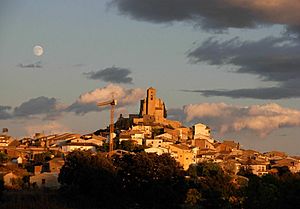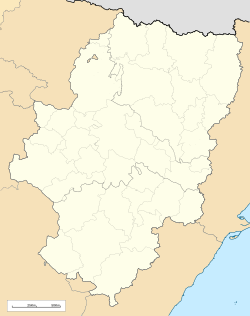Benabarre facts for kids
Quick facts for kids
Benabarre (Spanish)
|
|||
|---|---|---|---|
 |
|||
|
|||
 |
|||
| Country | |||
| Autonomous community | |||
| Province | Huesca | ||
| Comarca | Ribagorza | ||
| Judicial district | Barbastro | ||
| Area | |||
| • Total | 157.14 km2 (60.67 sq mi) | ||
| Elevation | 788 m (2,585 ft) | ||
| Population
(2018)
|
|||
| • Total | 1,111 | ||
| • Density | 7.070/km2 (18.312/sq mi) | ||
| Demonym(s) | Benabarrense | ||
| Time zone | UTC+1 (CET) | ||
| • Summer (DST) | UTC+2 (CEST) | ||
| Postal code |
22580
|
||
Benabarre is a charming town and municipality in the province of Huesca, Spain. It's located in the Ribagorza area of Aragon. The town is also known as Benavarri in the local Ribagorçan and Aragonese languages.
Benabarre is seen as the main historical and cultural center of the Ribagorza region. It's part of an area called La Franja, where people speak the Ribagorçan dialect of Catalan. Long ago, in old writings, the town was called Benavarri.
You can find Benabarre in the Pre-Pyrenees mountains. It's about 90 kilometers (56 miles) from Huesca and 65 kilometers (40 miles) from Lleida. The town sits at an altitude of 792 meters (2,598 feet) above sea level. Most of its land is part of the Noguera Ribagorçana river basin. To the north are the Castillo de Laguarres mountain range and to the south, the Montsec Range. A main road, the N-230, passes through Benabarre, connecting Lleida with the Val d'Aran.
Contents
History of Benabarre
Benabarre is a very old town. Some people think it might have been a Roman town called "Bargidum" or "Bargusia." It's believed that the town was given to the Arabs a long time ago, and it got its name from its first leader, Aben Avarre.
The town was taken back from Islamic rule around the year 1062. Ramiro I of Aragon, a king of Aragon, conquered it as part of a military campaign. He also took over nearby places like Luzás, Viacamp y Litera, and Tolva.
For a long time, Benabarre was the capital of the historic County of Ribagorza. This county was much bigger than the Ribagorza region we know today. It even included parts of what is now Catalonia.
During the Peninsular War (1808-1814), also known as the Spanish War of Independence, French troops were angry with the people of Benabarre. Because of this, they decided to make Graus the new capital of the region. Since then, Benabarre has not been the administrative capital. However, it is still very important for the culture and history of the area. The town also suffered a lot during the First Carlist War (1833-1840).
Town Government
Benabarre is run by a local government, just like other towns. The main leader of the town is called the Alcalde (Mayor). The mayor and other local officials are chosen by the people through elections.
Geography and Villages
The municipality of Benabarre includes several smaller villages and areas. Here are some of them:
- Aler: This village joined Benabarre before 1930. It's located at 669 meters (2,195 feet) high, near the Ésera river. You can find the hermitage of Nuestra Señora de las Ventosas to its northwest.
- Entença: This village is on the left side of the Cajigar river. It became part of Benabarre in 1974. The old castle here was the start of the Entença Barony.
- Benabarre (the main town): The streets in Benabarre still look like they did in medieval times. About 1 kilometer (0.6 miles) north of the town is the old Dominican Monastery of Our Lady of Linares.
- Caladrones: This village is on a hill near the Río Guart. Only a tower remains from its old castle. Caladrones and its villages, Ciscar and Entença, became part of Benabarre in 1974.
- Castilló del Pla: This village is at the bottom of the Corrodella range, 762 meters (2,500 feet) high. It used to be part of the Pilzán municipality.
- Ciscar: Located at 591 meters (1,939 feet) high, on the right side of the Cajigar river.
- Estaña: This village is 716 meters (2,349 feet) high in the mountains. These mountains separate the Guart River from the waters of "La Sosa" (part of the Cinca river).
- Pilzán: This village is very high up, at 905 meters (2,969 feet) above sea level. Until 1972, it was its own municipality.
- Purroy de la Solana: This village is located above a small valley called "El Molí." It was its own municipality until 1974. It also included the hermitage of Nuestra Señora del Pla.
Local Festivities and Traditions
Benabarre has some fun and interesting local celebrations:
- June 8th, Saint Medard: This is the town's main patron saint festival.
- A special part of this festival is the pastorada, which is a performance between a master and a shepherd.
- There's also a traditional dance called El ball dels palitrocs.
- Another fun event is the Baixada de Carricotxes, where people decorate floats and race them downhill.
- August Celebrations
- Ball dels Salvatges: This is a special play that has been brought back recently. It's a type of theater with dances where men of different social groups try to win over a lady. It happens every two years since 2010.
- A summer carnival is also held on the third weekend of August.
The Holy Week procession in Benabarre is also very well-known in the Ribagorza region. It's special because the "Romans" who lead the procession wear unique costumes that look like Renaissance soldiers. It's a beautiful sight for visitors, especially on Holy Friday at 10 PM, starting from the Our Lady of Valdeflores church square.
Important Landmarks
Benabarre has many interesting old buildings and places to visit:
- The Castle of the Counts of Ribagorça: This castle dates back to the 10th or 11th century.
- The parish church: Built in the 19th century.
- The medieval historical center: The old part of town with its ancient streets.
- Hermitage of Saint Medard.
- An old flour mill.
- An ice well: Used to store ice in the past.
- An oil mill from 1932.
- A public laundry from the 13th century.
Other notable religious buildings in the area include the Hermitage of Santa Maria of Caladrones and the Hermitage of San Salvador of Entença. There are also churches like Saint Romanus of Estaña, Saint Stephen of Estaña, Saint James of Entença, Saint Anne of Caladrones, Santa María of Aler, Saint Cristopher of Ciscar, and Saint Michael of Ciscar.
Famous People from Benabarre
Some important people were born or lived in Benabarre:
- Juan II de Ribagorza (or Juan de Aragón): He was a count, a leader in Catalonia, and a viceroy of Naples (1457-1528).
- Pedro García de Benavarre: A Gothic painter from the 15th century.
- Juan Bayarte Calasanz y Ávalos: He was a governor of Menorca and Ibiza in the 17th century.
- Jaume Santiveri i Piniés: A businessman who started the company Santiveri.
Twinned Towns
Benabarre is twinned with:
Images for kids
See also
 In Spanish: Benabarre para niños
In Spanish: Benabarre para niños






